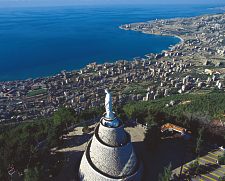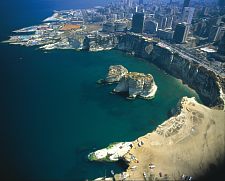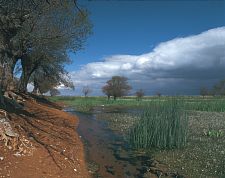|





| |
Blood borders
How a better Middle East would look
By Ralph Peters*
Armed Forces Journal
| June 2006
International borders are never completely just. But the degree of injustice
they inflict upon those whom frontiers force together or separate makes an
enormous difference often the difference between freedom and oppression,
tolerance and atrocity, the rule of law and terrorism, or even peace and war.
The most arbitrary and distorted borders in the world are in Africa and the
Middle East. Drawn by self-interested Europeans (who have had sufficient trouble
defining their own frontiers), Africa's borders continue to provoke the deaths
of millions of local inhabitants. But the unjust borders in the Middle East to
borrow from Churchill generate more trouble than can be consumed locally.
 
Maps of the Middle East Before
(left) and After (right) Redrawing (Click on map to enlarge)
While the Middle East has far more problems than dysfunctional
borders alone from cultural stagnation through scandalous inequality to deadly
religious extremism the greatest taboo in striving to understand the region's
comprehensive failure isn't Islam but the awful-but-sacrosanct international
boundaries worshipped by our own diplomats.
Of course, no adjustment of borders, however draconian, could make every
minority in the Middle East happy. In some instances, ethnic and religious
groups live intermingled and have intermarried. Elsewhere, reunions based on
blood or belief might not prove quite as joyous as their current proponents
expect. The boundaries projected in the maps accompanying this article redress
the wrongs suffered by the most significant "cheated" population groups, such as
the Kurds, Baluch and Arab Shia, but still fail to account adequately for Middle
Eastern Christians, Bahais, Ismailis, Naqshbandis and many another numerically
lesser minorities. And one haunting wrong can never be redressed with a reward
of territory: the genocide perpetrated against the Armenians by the dying
Ottoman Empire.
Yet, for all the injustices the borders re-imagined here leave unaddressed,
without such major boundary revisions, we shall never see a more peaceful Middle
East.
Even those who abhor the topic of altering borders would be well-served to
engage in an exercise that attempts to conceive a fairer, if still imperfect,
amendment of national boundaries between the Bosporus and the Indus. Accepting
that international statecraft has never developed effective tools short of war
for readjusting faulty borders, a mental effort to grasp the Middle East's
"organic" frontiers nonetheless helps us understand the extent of the
difficulties we face and will continue to face. We are dealing with colossal,
man-made deformities that will not stop generating hatred and violence until
they are corrected.
As for those who refuse to "think the unthinkable," declaring
that boundaries must not change and that's that, it pays to remember that
boundaries have never stopped changing through the centuries. Borders have never
been static, and many frontiers, from Congo through Kosovo to the Caucasus, are
changing even now (as ambassadors and special representatives avert their eyes
to study the shine on their wingtips).
Oh, and one other dirty little secret from 5,000 years of history: Ethnic
cleansing works.
Begin with the border issue most sensitive to American readers: For Israel to
have any hope of living in reasonable peace with its neighbors, it will have to
return to its pre-1967 borders with essential local adjustments for legitimate
security concerns. But the issue of the territories surrounding Jerusalem, a
city stained with thousands of years of blood, may prove intractable beyond our
lifetimes. Where all parties have turned their god into a real-estate tycoon,
literal turf battles have a tenacity unrivaled by mere greed for oil wealth or
ethnic squabbles. So let us set aside this single overstudied issue and turn to
those that are studiously ignored.
The most glaring injustice in the notoriously unjust lands between the Balkan
Mountains and the Himalayas is the absence of an independent Kurdish state.
There are between 27 million and 36 million Kurds living in contiguous regions
in the Middle East (the figures are imprecise because no state has ever allowed
an honest census). Greater than the population of present-day Iraq, even the
lower figure makes the Kurds the world's largest ethnic group without a state of
its own. Worse, Kurds have been oppressed by every government controlling the
hills and mountains where they've lived since Xenophon's day.
The U.S. and its coalition partners missed a glorious chance to begin to correct
this injustice after Baghdad's fall. A Frankenstein's monster of a state sewn
together from ill-fitting parts, Iraq should have been divided into three
smaller states immediately. We failed from cowardice and lack of vision,
bullying Iraq's Kurds into supporting the new Iraqi government which they do
wistfully as a quid pro quo for our good will. But were a free plebiscite to be
held, make no mistake: Nearly 100 percent of Iraq's Kurds would vote for
independence.
As would the long-suffering Kurds of Turkey, who have endured decades of violent
military oppression and a decades-long demotion to "mountain Turks" in an effort
to eradicate their identity. While the Kurdish plight at Ankara's hands has
eased somewhat over the past decade, the repression recently intensified again
and the eastern fifth of Turkey should be viewed as occupied territory. As for
the Kurds of Syria and Iran, they, too, would rush to join an independent
Kurdistan if they could. The refusal by the world's legitimate democracies to
champion Kurdish independence is a human-rights sin of omission far worse than
the clumsy, minor sins of commission that routinely excite our media. And by the
way: A Free Kurdistan, stretching from Diyarbakir through Tabriz, would be the
most pro-Western state between Bulgaria and Japan.
A just alignment in the region would leave Iraq's three Sunni-majority provinces
as a truncated state that might eventually choose to unify with a Syria that
loses its littoral to a Mediterranean-oriented Greater Lebanon: Phoenecia
reborn. The Shia south of old Iraq would form the basis of an Arab Shia State
rimming much of the Persian Gulf. Jordan would retain its current territory,
with some southward expansion at Saudi expense. For its part, the unnatural
state of Saudi Arabia would suffer as great a dismantling as Pakistan.
A root cause of the broad stagnation in the Muslim world is the Saudi royal
family's treatment of Mecca and Medina as their fiefdom. With Islam's holiest
shrines under the police-state control of one of the world's most bigoted and
oppressive regimes a regime that commands vast, unearned oil wealth the
Saudis have been able to project their Wahhabi vision of a disciplinarian,
intolerant faith far beyond their borders. The rise of the Saudis to wealth and,
consequently, influence has been the worst thing to happen to the Muslim world
as a whole since the time of the Prophet, and the worst thing to happen to Arabs
since the Ottoman (if not the Mongol) conquest.
While non-Muslims could not effect a change in the control of Islam's holy
cities, imagine how much healthier the Muslim world might become were Mecca and
Medina ruled by a rotating council representative of the world's major Muslim
schools and movements in an Islamic Sacred State a sort of Muslim
super-Vatican where the future of a great faith might be debated rather than
merely decreed. True justice which we might not like would also give Saudi
Arabia's coastal oil fields to the Shia Arabs who populate that subregion, while
a southeastern quadrant would go to Yemen. Confined to a rump Saudi Homelands
Independent Territory around Riyadh, the House of Saud would be capable of far
less mischief toward Islam and the world.
Iran, a state with madcap boundaries, would lose a great deal of territory to
Unified Azerbaijan, Free Kurdistan, the Arab Shia State and Free Baluchistan,
but would gain the provinces around Herat in today's Afghanistan a region with
a historical and linguistic affinity for Persia. Iran would, in effect, become
an ethnic Persian state again, with the most difficult question being whether or
not it should keep the port of Bandar Abbas or surrender it to the Arab Shia
State.
What Afghanistan would lose to Persia in the west, it would gain in the east, as
Pakistan's Northwest Frontier tribes would be reunited with their Afghan
brethren (the point of this exercise is not to draw maps as we would like them
but as local populations would prefer them). Pakistan, another unnatural state,
would also lose its Baluch territory to Free Baluchistan. The remaining
"natural" Pakistan would lie entirely east of the Indus, except for a westward
spur near Karachi.
The city-states of the United Arab Emirates would have a mixed fate as they
probably will in reality. Some might be incorporated in the Arab Shia State
ringing much of the Persian Gulf (a state more likely to evolve as a
counterbalance to, rather than an ally of, Persian Iran). Since all puritanical
cultures are hypocritical, Dubai, of necessity, would be allowed to retain its
playground status for rich debauchees. Kuwait would remain within its current
borders, as would Oman.
In each case, this hypothetical redrawing of boundaries reflects ethnic
affinities and religious communalism in some cases, both. Of course, if we
could wave a magic wand and amend the borders under discussion, we would
certainly prefer to do so selectively. Yet, studying the revised map, in
contrast to the map illustrating today's boundaries, offers some sense of the
great wrongs borders drawn by Frenchmen and Englishmen in the 20th century did
to a region struggling to emerge from the humiliations and defeats of the 19th
century.
Correcting borders to reflect the will of the people may be impossible. For now.
But given time and the inevitable attendant bloodshed new and natural
borders will emerge. Babylon has fallen more than once.
Meanwhile, our men and women in uniform will continue to fight for security from
terrorism, for the prospect of democracy and for access to oil supplies in a
region that is destined to fight itself. The current human divisions and forced
unions between Ankara and Karachi, taken together with the region's
self-inflicted woes, form as perfect a breeding ground for religious extremism,
a culture of blame and the recruitment of terrorists as anyone could design.
Where men and women look ruefully at their borders, they look enthusiastically
for enemies.
From the world's oversupply of terrorists to its paucity of energy supplies, the
current deformations of the Middle East promise a worsening, not an improving,
situation. In a region where only the worst aspects of nationalism ever took
hold and where the most debased aspects of religion threaten to dominate a
disappointed faith, the U.S., its allies and, above all, our armed forces can
look for crises without end. While Iraq may provide a counterexample of hope
if we do not quit its soil prematurely the rest of this vast region offers
worsening problems on almost every front.
If the borders of the greater Middle East cannot be amended to reflect the
natural ties of blood and faith, we may take it as an article of faith that a
portion of the bloodshed in the region will continue to be our own.
WHO WINS, WHO LOSES
Winners
Afghanistan
Arab Shia State
Armenia
Azerbaijan
Free Baluchistan
Free Kurdistan
Iran
Islamic Sacred State
Jordan
Lebanon
Yemen
Losers
Afghanistan
Iran
Iraq
Israel
Kuwait
Pakistan
Qatar
Saudi Arabia
Syria
Turkey
United Arab Emirates
West Bank
*Ralph Peters is the author of the new book "Never Quit
the Fight," published on July 4th, 2006.
|